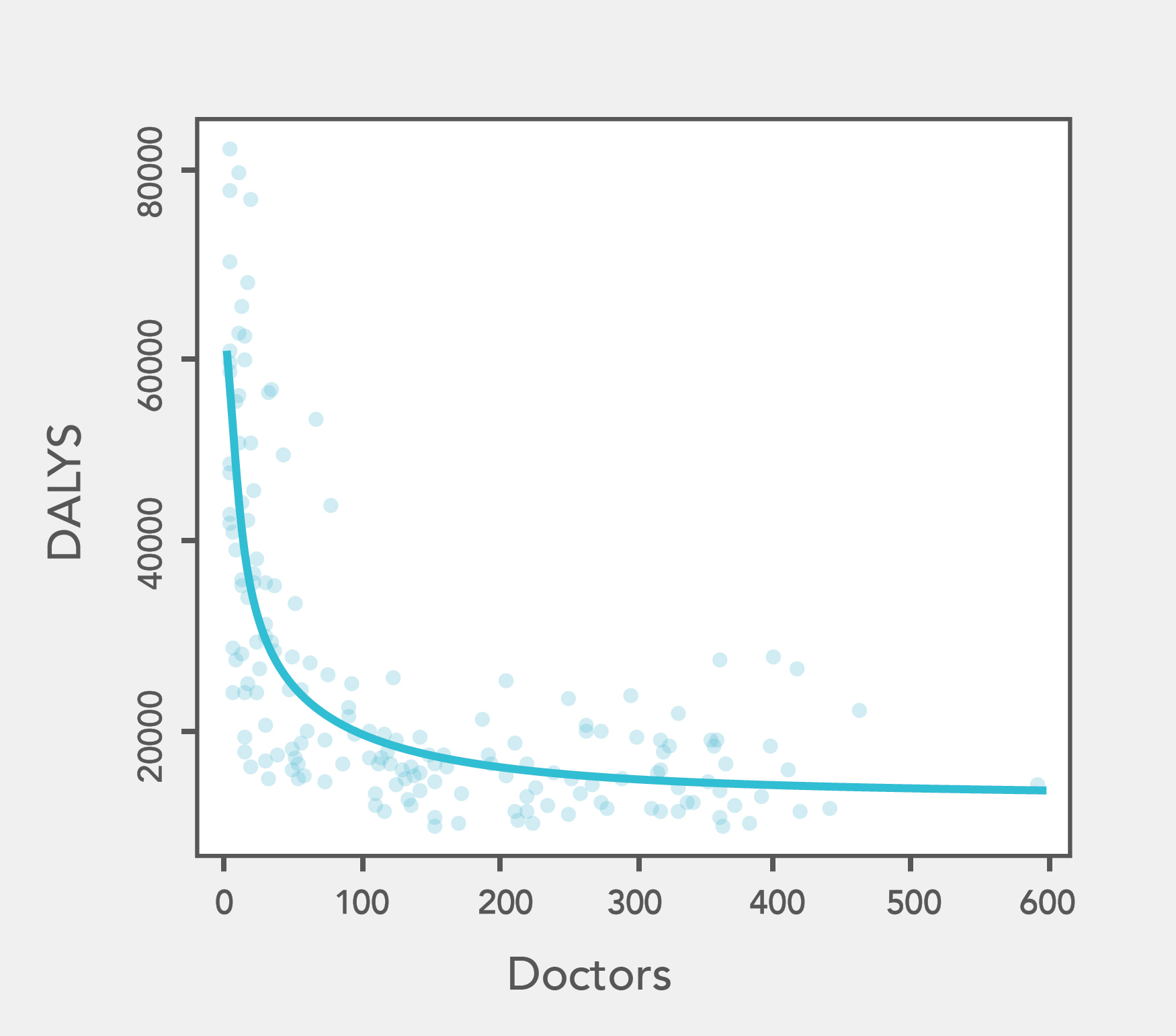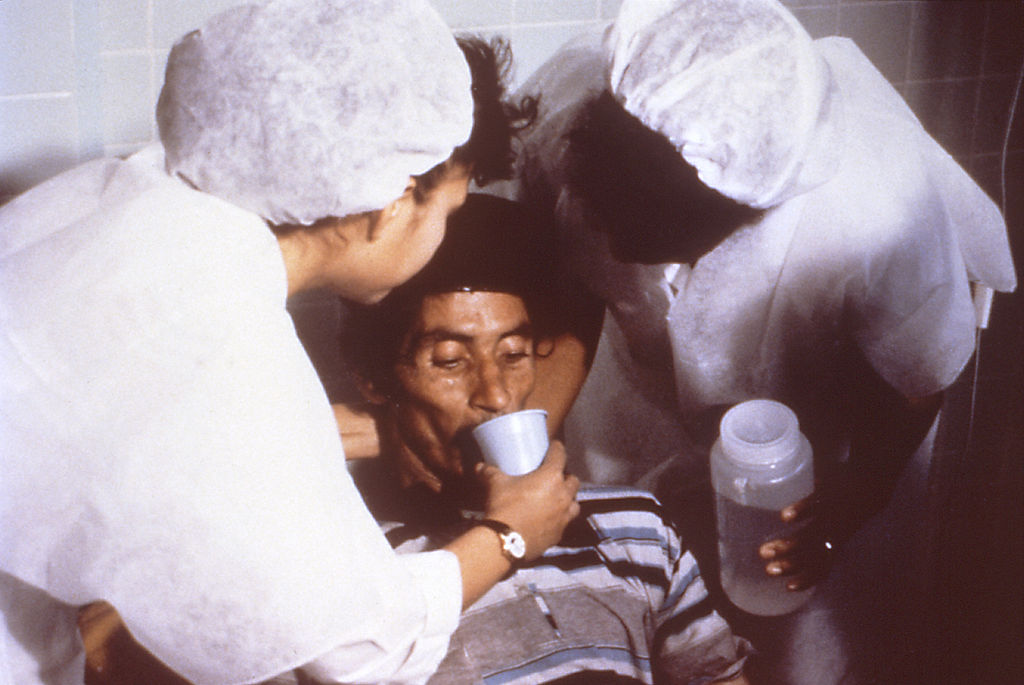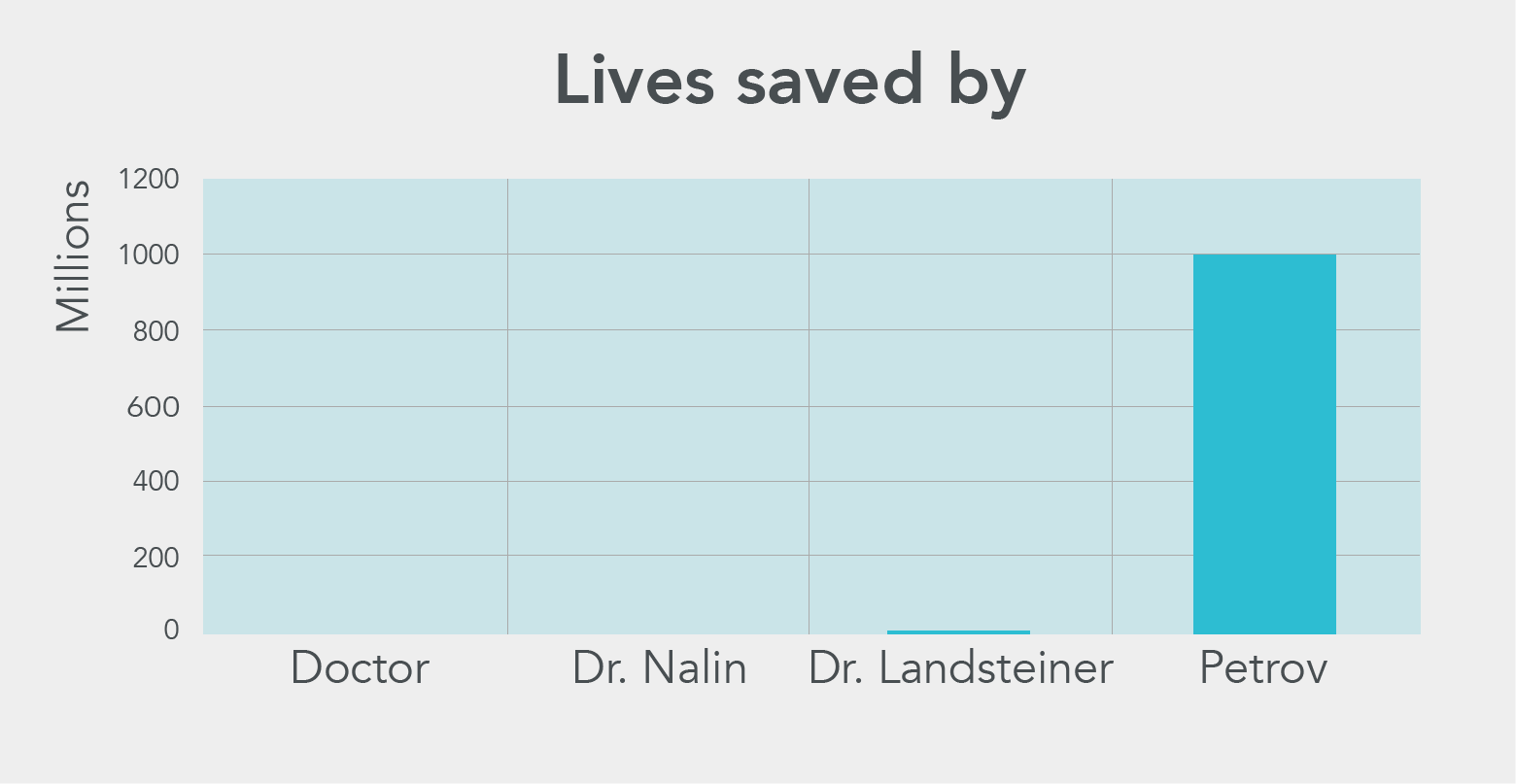It’s easy to feel like one can person can’t make a difference. The world has so many big problems, and they often seem impossible to solve.
So when we started 80,000 Hours — with the aim of helping people do good with their careers — one of the first questions we asked was “how much difference can one person really make?”
We learned that while many common ways to do good, such as becoming a doctor, have less impact than you might first think; others have allowed certain people to achieve an extraordinary impact.
In other words, one person can make a difference, but they might have to do something a little unconventional.
In this article, we start by estimating how much good you could do by becoming a doctor. Then, we share stories about some of the highest-impact people in history, and consider what they mean for your career.
How much impact do doctors have?
Many people who want to help others become doctors. One of our early readers, Dr. Greg Lewis, did exactly that. “I want to study medicine because of a desire I have to help others,” he wrote on his university application, “and so the chance of spending a career doing something worthwhile [is something] I can’t resist.”
So, we wondered: how much difference does becoming a doctor really make? In 2012, we teamed up with Greg to find out.
Since a doctor’s main purpose is to improve health, we tried to figure out how much extra “health” one doctor actually adds to humanity. We found that, on average in the course of their career, a doctor in the UK will enable their patients to live an extra combined 140 years of healthy life, either by extending their lifespans or by improving their overall health. There is, of course, a huge amount of uncertainty in this figure, but the real figure is unlikely to be more than ten times higher than 140.[1]
Using a standard conversion rate (used by the World Bank among other institutions) of 30 extra years of healthy life to one “life saved,” 140 years of healthy life is equivalent to 5 lives saved. This is clearly a significant impact, however it’s less of an impact than many people expect doctors to have.
There are three main reasons for this:
- Researchers largely agree that medicine has only increased average life expectancy by a few years. Most gains in life expectancy over the last 100 years have instead occurred due to better nutrition, improved sanitation, increased wealth, and other factors.
- Doctors are only one part of the medical system, which also relies on nurses and hospital staff, as well as overhead and equipment. The impact of medical interventions is shared between all of these elements.
- Most importantly, there are already a lot of doctors in the developed world, so if you don’t become a doctor, someone else will be available to perform the most critical procedures. Additional doctors therefore only enable us to carry out procedures that deliver less significant and less certain results.
This last point is illustrated by the chart below, which compares the impact of doctors in different countries. The y-axis shows the amount of ill health in the population, measured in Disability-Adjusted Life Years (aka “DALYs”) per 100,000 people, where one DALY equals one year of life lost due to ill health. The x-axis shows the number of doctors per 100,000 people.

DALYs per 100,000 people versus doctors per 100,000 people. We used WHO data from 2004. The line is the best fitting hyperbola determined by non-linear least square regression. Full explanation in this paper.
You can see that the curve goes nearly flat once you have more than 150 doctors per 100,000 people. After this point (which almost all developed countries meet), additional doctors only achieve a small impact on average.
So if you become a doctor in a rich country like the US or UK, you may well do more good than you would in many other jobs, and if you would be an exceptional doctor, then you’ll have a bigger impact than these averages. But it probably won’t be a huge impact.
These findings motivated Greg to switch from clinical medicine into public health.
Who were the highest-impact people in history?
Despite this uninspiring statistic about how many lives a doctor saves, some doctors have had much more impact than this. Let’s look at some examples of the highest-impact careers in history, and see what we might learn from them. First, let’s turn to medical research.
In 1968, while working in a refugee camp on the border of Bangladesh and Burma, Dr. David Nalin discovered a breakthrough treatment for patients suffering from diarrhea. He realised that giving patients water mixed with the right concentration of salt and sugar would rehydrate them at the same rate at which they lost water. This prevented death from dehydration much more cheaply than did the conventional treatment of using an intravenous drip.

Since then, this astonishingly simple treatment has been used all over the world, and the annual rate of child deaths from diarrhea has plummeted from 5 million to 1.3 million. Researchers estimate that the therapy has saved about 50 million lives, mostly children’s.[2]
If Dr. Nalin had not been around, someone else would, no doubt, have discovered this treatment eventually. However, even if we imagine that he sped up the roll-out of the treatment by only five months, his work alone would have saved about 500,000 lives. This is a very approximate estimate, but it makes his impact more than 100,000 times greater than that of an ordinary doctor:

But even just within medical research, Dr. Nalin is far from the most extreme example of a high-impact career. For example, one estimate puts Karl Landsteiner’s discovery of blood groups as saving tens of millions of lives.[3]

Leaving the medical field, later in the guide, we’ll cover the story of a hugely impactful mathematician, Alan Turing, and bureaucrat, Viktor Zhdanov.
Or, let’s think even more broadly. Roger Bacon and Galileo pioneered the scientific method, without which none of the discoveries we covered above would have been possible, along with other major technological breakthroughs like the Industrial Revolution. These individuals were able to do vastly more good than even outstanding medical practitioners.
The unknown Soviet Lieutenant Colonel who saved your life

Or consider the story of Stanislav Petrov, a Lieutenant Colonel in the Soviet army during the Cold War. In 1983, Petrov was on duty in a Soviet missile base when early warning systems apparently detected an incoming missile strike from the United States. Protocol dictated that the Soviets order a return strike.
But Petrov didn’t push the button. He reasoned that the number of missiles was too small to warrant a counterattack, thereby disobeying protocol.
If he had ordered a strike, there’s at least a reasonable chance hundreds of millions would have died. The two countries may have even ended up engaged in an all-out nuclear war, leading to billions of deaths and, potentially, the end of civilisation. If we’re being conservative, we might quantify his impact by saying he saved one billion lives. But that could be an underestimate, because a nuclear war would also have devastated scientific, artistic, economic and all other forms of progress leading to a huge loss of life and well-being over the long run. Yet even with the lower estimate, Petrov’s impact likely dwarfs that of Nalin and Landsteiner.

What does this spread in impact mean for your career?
We’ve seen that some careers have had huge positive effects, and some have vastly more than others.
Some component of this is due to luck – the people mentioned above were in the right place at the right time, affording them the opportunity to have an impact that they might not have otherwise received. You can’t guarantee you’ll make an important medical discovery.
But it wasn’t all luck: Landsteiner and Nalin chose to use their medical knowledge to solve some of the most harmful health problems of their day, and it was foreseeable that someone high up in the Soviet military could have a large impact by preventing conflict during the Cold War. So, what does this mean for you?
People often wonder how they can “make a difference”, but if some careers can result in thousands of times more impact than others, this isn’t the right question. Two career options can both “make a difference”, but one could be dramatically better than the other.
Instead, the key question is, “how can I make the most difference?” In other words: what can you do to give yourself a chance of having one of the highest-impact careers? Because the highest-impact careers achieve so much, a small increase in your chances means a great deal.
The examples above also show that the highest-impact paths might not be the most obvious ones. Being an officer in the Soviet military doesn’t sound like the best career for a would-be altruist, but Petrov probably did more good than our most celebrated leaders, not to mention our most talented doctors. Having a big impact might require doing something a little unconventional.
So how much impact can you have if you try, while still doing something personally rewarding? It’s not easy to have a big impact, but there’s a lot you can do to increase your chances. That’s what we’ll cover in the next couple of articles.
But first, let’s clarify what we mean by “making a difference”. We’ve been talking about lives saved so far, but that’s not the only way to do good in the world.
What does it mean to “make a difference?”
Everyone talks about “making a difference” or “changing the world” or “doing good” or “impact”, but few ever define what they mean.
So here’s our definition. Your social impact is given by:
The number of people whose lives you improve, and how much you improve them, over the long-term.
This means you can increase your social impact in three ways: by helping more people, or by helping the same number of people to a greater extent (pictured below), or by doing something which has benefits that last for a longer time.
We think the latter is especially important, because many of our actions affect future generations.
For example, if you improve the quality of government decision-making, you might not see many quantifiable short-term results, but you will have solved lots of other problems over the long term.

Optional: Why did we choose this definition?
Many people disagree about what it means to make the world a better place. But most agree that it’s good if people have happier, more fulfilled lives, in which they reach their potential. So our definition captures this idea.
Moreover, as we’ll show, some careers do far more to improve lives than others, so it captures a really important difference between options. If some paths can do good equivalent to saving hundreds of lives, while others have little impact at all, that’s an important difference.
But, the definition is also broad enough to cover many different ways to make the world a better place. It’s even broad enough to cover environmental protection, since if we let the environment degrade, the future of civilisation might be threatened. In that way, protecting the environment improves lives.
Many of our readers also expand the scope of their concern to include non-human animals, which is one reason why we did a profile on factory farming.
That said, the definition doesn’t include everything that might matter. You might think the environment deserves protection even if it doesn’t make people better off. Similarly, you might value things like justice and aesthetic beauty for their own sake.
In practice, our readers value many different things. Our approach is to focus on how to improve lives, and then let people independently take account of what else they value. To make this easier, we try to highlight the main value judgments behind our work. It turns out there’s a lot we can say about how to do good in general, despite all these differences.
How to measure social impact?
We are always uncertain about how much impact different actions will have, but that’s okay, because we can use probabilities to make the comparison. For instance, a 90% chance of helping 100 people is roughly equivalent to a 100% chance of helping 90 people. Though we’re uncertain, we can quantify our uncertainty and make progress.
Moreover, we can still use rules of thumb to compare different courses of action. For instance, in an upcoming article we argue that, all else equal, it’s higher-impact to work on neglected areas. So, even if we can’t precisely measure social impact, we can still be strategic by picking neglected areas. We’ll cover many more rules of thumb for increasing your impact in the upcoming articles.
(Read more about our definition of social impact and the value assumptions that lie behind our work.)
In our career review on medical careers, which is based on the research we mention, we provide an optimistic all considered estimate of 4 DALYs averted per year (mean). Over a 35 year career, that’s 140 DALYs averted. Individual doctors will do more or less depending on their ability and speciality. (Source: World Bank, p. 402, retrieved 31 March 2016.) ↩︎
Since the adoption of this inexpensive and easily applied intervention, the worldwide mortality rate for children with acute infectious diarrhoea has plummeted from 5 million to about 1.3 million deaths per year. Over fifty million lives have been saved in the past 40 years by the implementation of ORT. (Source: Science Heroes. Archived link, retrieved 4 March 2016.)
Very roughly, this means 50/40 = 1.25 million lives have been saved per year. So if Dr Nalin sped up the discovery by 5 months (just a guess), that means that (5/12)*1.25 = 0.52 million extra lives were saved by his actions. This is a highly approximate estimate and could easily be off by an order of magnitude. See more comments in the next footnote ↩︎
Every source quoted an amazing number of transfusions and potential lives saved in countries and regions worldwide. High-impact years began around 1955 and calculations are loosely based on 1 life saved per 2.7 units of blood transfused. In the USA alone an estimated 4.5 million lives are saved each year. From these data, I determined that 1.5% of the population was saved annually by blood transfusions and I applied this percentage on population data from 1950-2008 for North America, Europe, Australia, New Zealand, and parts of Asia and Africa. (Source: Science Heroes. Archived link, retrieved 4 March 2016.)
This rate may inflate the effectiveness of transfusions in the early decades, but also excludes the developing world entirely.
If we assume a constant number of lives saved per year, then that’s about 10 million lives per year. If he sped up the discovery by two years, then that’s 20 million lives saved.
This is a highly approximate estimate and could easily be off by an order of magnitude in either direction, and seem more likely to be too high than too low. We’re a bit sceptical of the Science Heroes figures. Moreover, our attempt at modelling the speed-up is very simple. Since most of the lives were saved in the modern era once a large number of people had medical care, it’s possible that speeding up the discovery wouldn’t have had much impact at all. On the other hand, the discovery of blood groups probably made other scientific advances possible, and we’re ignoring their impact. Nevertheless, the basic point stands: Landsteiner’s impact was likely vastly greater than that of a typical doctor. ↩︎

Good article!
However, the footnotes at the end of the article require some formatting work, at least for me (Windows laptop, Brave browser). Overall I'm also really impressed by the quality of the website, it's great for the professional outlook of the organization :)
Thanks for the report. This is fixed.
ORT was not invented by one guy. There was a pretty large team that contributed to the effort, my grandfather-in-law included. https://en.wikipedia.org/wiki/Oral_rehydration_therapy#History
"Researchers largely agree that medicine has only increased average life expectancy by a few years. Most gains in life expectancy over the last 100 years have instead occurred due to better nutrition, improved sanitation, increased wealth, and other factors."
So true this :)